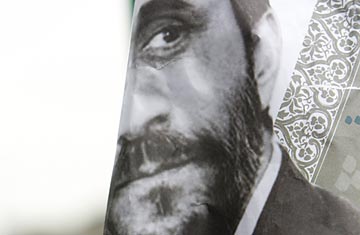
A supporter of Mahmoud Ahmadinejad holds a poster with the President's image during a gathering to celebrate Ahmadinejad's declared election victory in Tehran
There is no denying that the news clips from Tehran are dramatic, unprecedented in violence and size since the mullahs came to power in 1979. They're possibly even augurs of real change. But can we trust them? Most of the demonstrations and rioting I've seen in the news are taking place in north Tehran, around Tehran University and in public places like Azadi Square. These are, for the most part, areas where the educated and well-off live — Iran's liberal middle class. These are also the same neighborhoods that little doubt voted for Mir-Hossein Mousavi, President Mahmoud Ahmadinejad's rival, who now claims that the election was stolen. But I have yet to see any pictures from south Tehran, where the poor live. Or from other Iranian slums.
Some facts about Iran's election will hopefully emerge in the coming weeks, with perhaps even credible evidence that the election was rigged. But until then, we need to add a caveat to everything we hear and see coming out of Tehran. For too many years now, the Western media have looked at Iran through the narrow prism of Iran's liberal middle class — an intelligentsia that is addicted to the Internet and American music and is more ready to talk to the Western press, including people with money to buy tickets to Paris or Los Angeles. Reading Lolita in Tehran is a terrific book, but does it represent the real Iran?
Before we settle on the narrative that there has been a hard-line takeover in Iran, an illegitimate coup d'état, we need to seriously consider the possibility that there has been a popular hard-line takeover, an electoral mandate for Ahmadinejad and his policies. One of the only reliable, Western polls conducted in the run-up to the vote gave the election to Ahmadinejad — by higher percentages than the 63% he actually received. The poll even predicted that Mousavi would lose in his hometown of Tabriz, a result that many skeptics have viewed as clear evidence of fraud. The poll was taken all across Iran, not just the well-heeled parts of Tehran. Still, the poll should be read with a caveat as well, since some 50% of the respondents were either undecided or wouldn't answer.
No doubt, Iran will come out of last Friday's election a different country. But it would serve us well to put aside our prism that has led us to misunderstand Iran for so many years, an anticipation that there would be a liberal counter-revolution in the country. Mousavi is far from the liberal democrat that many in the West would like to believe he is. The truth is, Ahmadinejad may be the President the Iranians want, and we may have to live with an Iran to Iranians' liking and not to ours.
The absolute worst things we could do at this point would be to declare Iran's election fraudulent, refuse to talk to the regime and pile on more sanctions. Hostility will only strengthen Ahmadinejad and encourage the hard-liners and secret police. We should never forget that Iran's spiritual leader, Ayatullah Khameinei, along with Ahmadinejad, have the full, if undeclared, backing of both the Revolutionary Guards and the army, and they are not afraid to use those resources to back up their mandate.
Baer, a former CIA field officer assigned to the Middle East, is TIME.com's intelligence columnist and the author of See No Evil and, most recently, The Devil We Know: Dealing with the New Iranian Superpower.
